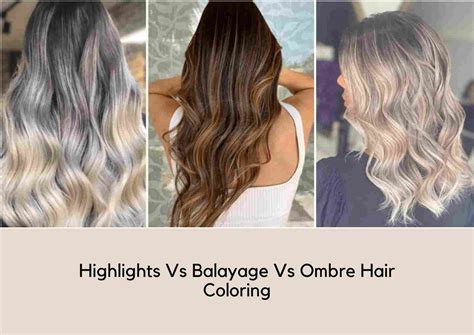The pursuit of the perfect hair color can be a daunting task, especially when faced with a myriad of options. Two popular techniques that have gained significant traction in recent years are highlights and balayage, each offering distinct advantages and aesthetics. This comprehensive guide aims to shed light on the key differences between highlights and balayage, helping you make an informed decision for your next hair transformation.

Understanding Highlights
Highlights involve lightening specific strands of hair to create a contrasting effect. This technique is often used to add depth, dimension, and brightness to hair.
How Are Highlights Done?
- The stylist selects individual strands of hair and applies bleach or lightener.
- The processing time varies depending on the desired level of lift.
- A toner is often used to neutralize brassy tones and enhance color.
Benefits of Highlights
- Adds brightness and contrast to hair.
- Creates a polished and sophisticated look.
- Suitable for various hair textures and colors.
- Can be customized to achieve desired effects, such as chunky or subtle highlights.
Types of Highlights
- Foil Highlights: The selected strands are wrapped in foil to isolate them during processing. This technique provides precise and controlled results.
- Cap Highlights: A perforated cap is placed over the head, and hair strands are pulled through the holes for highlighting. This method creates a more natural and blended look.
- Comb Highlights: A comb with teeth is used to backcomb hair, creating sections for highlighting. This technique allows for a subtle and gradual transition of color.
Understanding Balayage
Balayage is a freehand highlighting technique that involves painting lightener onto the hair’s surface. The resulting effect is a more natural and sun-kissed look.
How Is Balayage Done?
- The stylist uses a brush or sponge to apply lightener in a sweeping motion.
- The lightener is typically placed on the mid-lengths and ends of the hair.
- No foil or plastic wrap is used, allowing the lightener to blend seamlessly with the natural hair color.
Benefits of Balayage
- Creates a natural and sun-kissed look.
- Adds dimension and movement to hair.
- Requires less maintenance compared to highlights.
- Suitable for various hair types, including fine or dark hair.
Types of Balayage
- Ombré Balayage: A gradual transition from dark roots to lighter ends.
- Sombré Balayage: A softer and more subtle transition of color.
- Reverse Balayage: Lightening the roots while leaving the ends darker.
- Ecaille Balayage: Inspired by tortoiseshell patterns, creating a mix of warm and cool tones.
Highlights vs Balayage: A Comparative Analysis
To assist you in making an informed decision, here is a comparative analysis of highlights and balayage:
| Characteristic | Highlights | Balayage |
|---|---|---|
| Method | Precise and controlled | Freehand and artistic |
| Application | Specific strands | Surface painting |
| Isolation | Foil or cap | None |
| Result | Contrasting effect | Natural and blended |
| Maintenance | Requires regular touch-ups | Less maintenance |
| Cost | Generally more expensive | Similar to highlights |
Choosing the Right Technique for You
The choice between highlights and balayage depends on your personal preferences and hair goals:
- For a striking and defined look: Highlights are a better option.
- For a natural and sun-kissed effect: Balayage is the preferred choice.
- For fine or dark hair: Balayage can create depth and dimension without overwhelming the hair.
- For low-maintenance: Balayage tends to require less frequent touch-ups.
- Consider your budget: Highlights are typically more expensive than balayage.
Common Mistakes to Avoid
- Over-processing: Bleaching or lightening the hair can cause damage if not done correctly.
- Choosing the wrong technique: Ensure the technique matches your desired look and hair type.
- Ignoring maintenance: Both highlights and balayage require regular care to maintain their vibrancy.
- DIY experiments: It’s best to leave hair coloring to professionals to avoid potential disasters.
- Unrealistic expectations: Natural hair color and texture may limit the achievable results.
Conclusion
Highlights and balayage offer distinct advantages and can transform your hair in unique ways. Understanding the differences between these techniques is crucial for achieving the desired look. Whether you crave a bold and striking contrast or a natural and sun-kissed glow, consult a reputable stylist to guide you through the decision-making process. Remember to consider your hair goals, personal style, and maintenance preferences to make an informed choice that will enhance your overall appearance.
